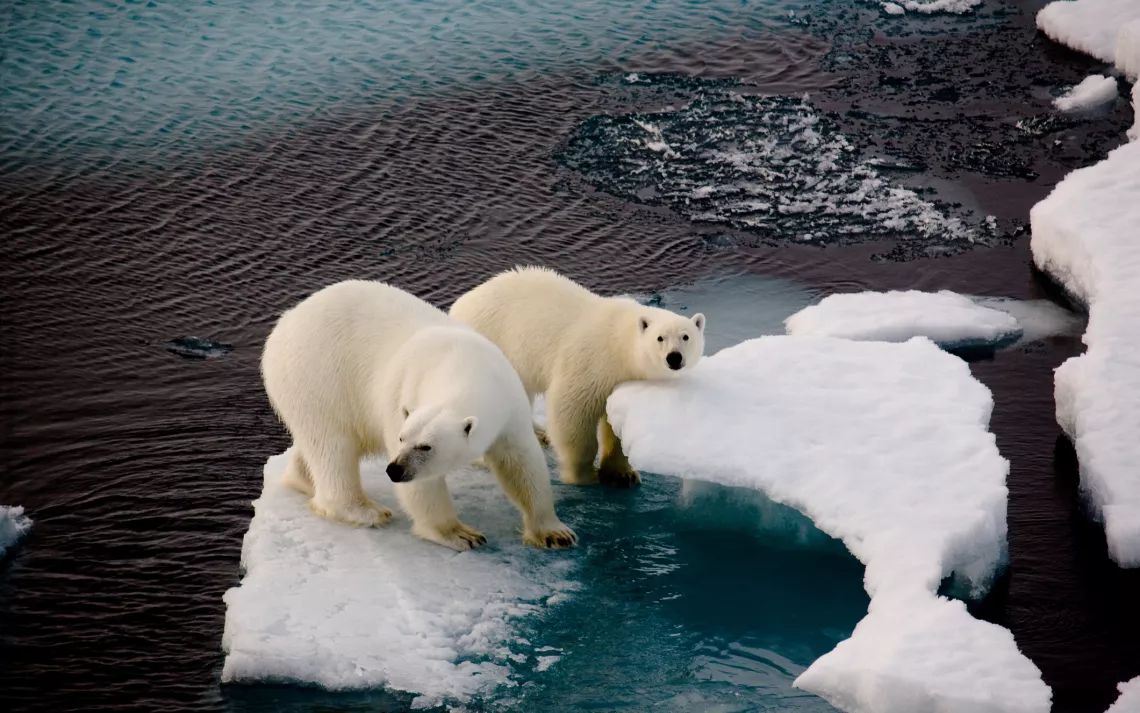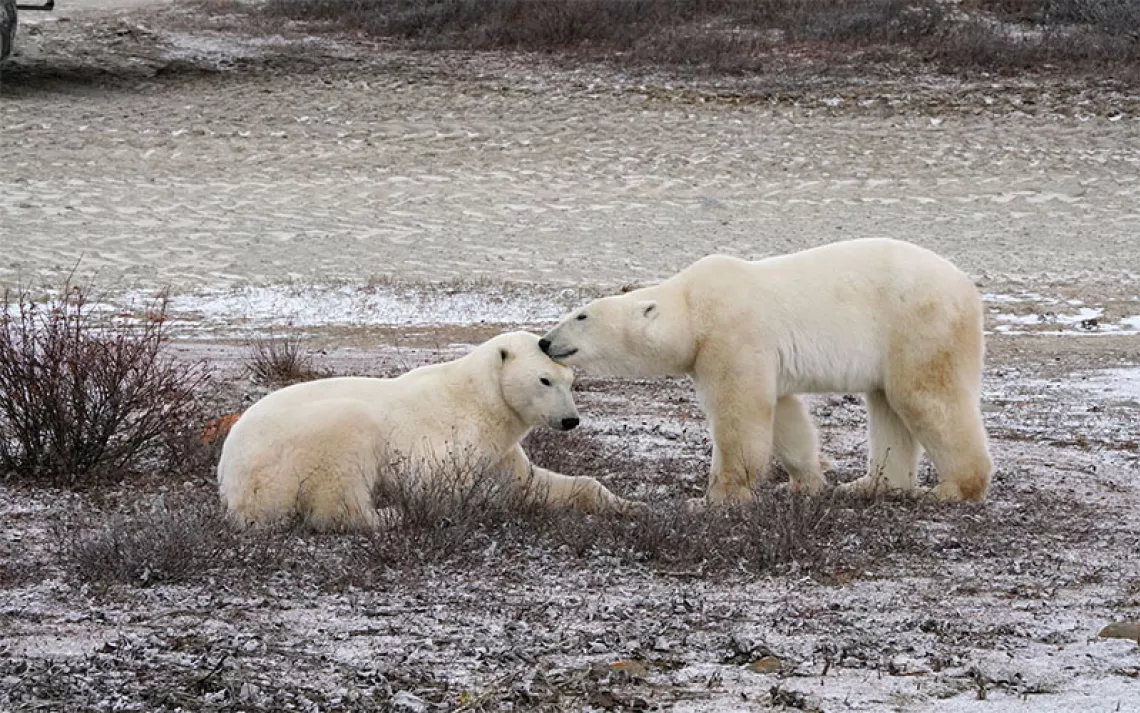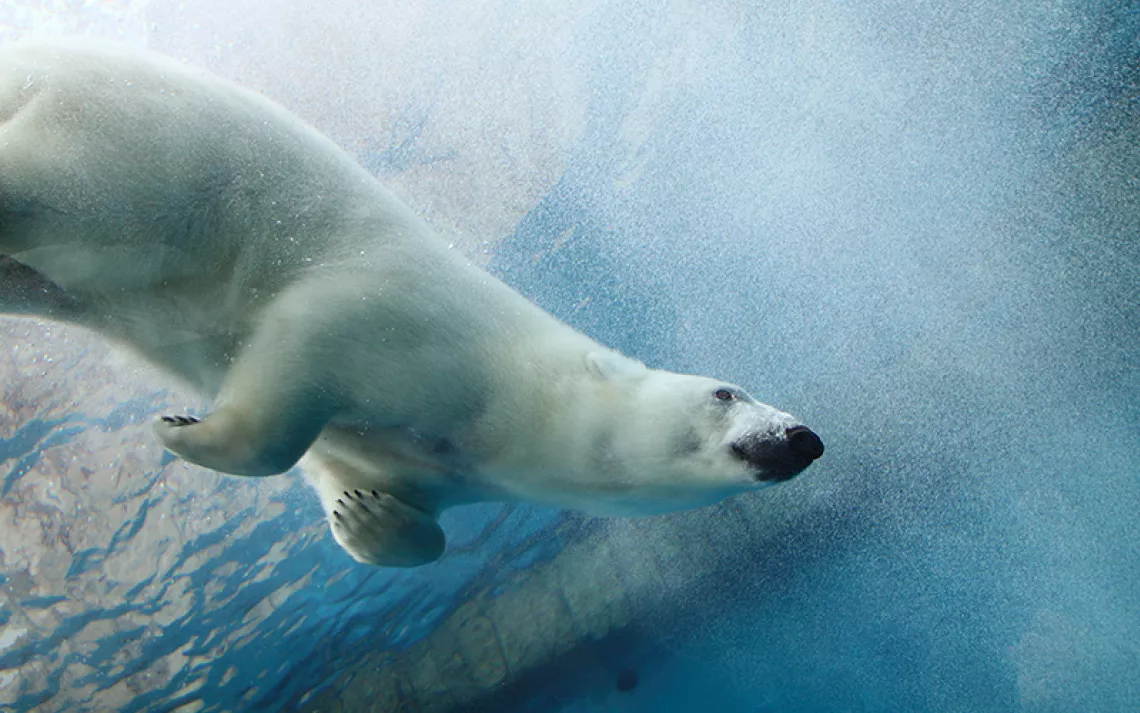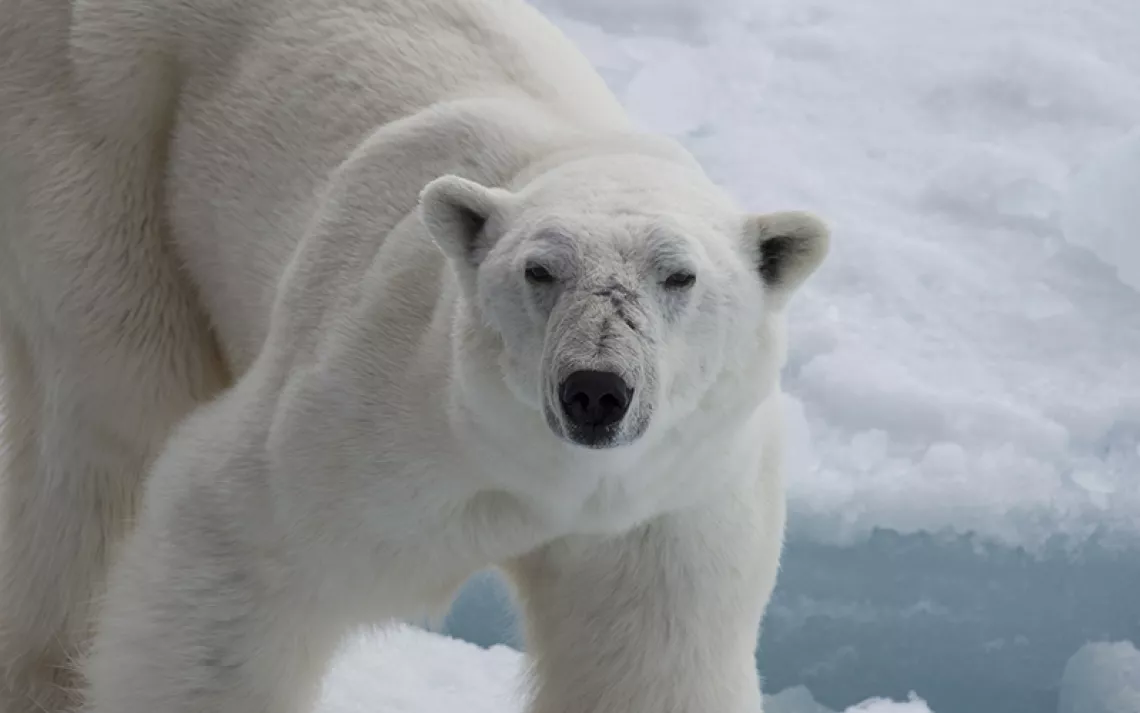Chilling Lessons
On the Arctic's ephemeral terrain, polar bears teach humans to survive

"I WAS WALKING BY MYSELF way out on the pack ice, and all of a sudden, on the far side of a big flat place ... I saw a polar bear."
The old man peered at the ice-covered Arctic Ocean. He was lean and bright eyed, and everyone said he was the greatest Inupiaq Eskimo hunter. He possessed a singular and mystifying genius, as if he could project himself into an animal's mind. I could feel it especially when he told of his encounters with nanuq--the polar bear.
"I had no place to hide on that flat ice," he recalled. "And I knew the bear would see my dark parka. So I couldn't get any closer."
A confident smile crossed the man's face as he remembered what happened next.
"I lay down on the ice, sideways to the bear, so he'd see something long and dark, and I started acting like a seal that comes up through a crack to sleep on the ice."
The hunter paused to fasten my attention, as he often did when he had something important to say.
"I wanted that bear to hunt me," he said. "Every once in a while, I lifted my head really quick, like a seal looking around to make sure there's no danger. Then I put my head back down, same as a seal when it starts sleeping again. Pretty soon I saw the bear crawling toward me, really slow--hunting that little seal, he thinks."
There was no hint of recollected fear in the old man's voice, nor a trace of bluster or bravado.
"That bear kept coming closer and closer. I waited till he got really close. And by the time I shot, I knew there was no way to miss. That's how I got the bear."
He smiled openly now, straightforwardly proud to be an Inupiaq hunter who embodied the craft and brilliance of his people.
I had many chances to hear the old man's stories during the year I spent with the Inupiaq people in the mid-1960s, in the village of Wainwright on Alaska's North Slope. As a young graduate student in anthropology, I was helping to record their hunting ways, their knowledge of sea ice, and their strategies for survival in one of Earth's most challenging environments. The U.S. Air Force sponsored me and would incorporate the information I gathered into pilots' polar survival manuals.
On my first seal hunt, I ventured several miles out on the early winter ice with an Inupiaq man. The temperature was far below zero. The intensely cold snow crackled under our boots, and we found a wide fissure where dense clouds of steam rose from the black water. We stood near the ice edge with our rifles, watching for seals that might bob up nearby.

Sign up to receive Sierra News & Views
Get articles like this one sent directly to your inbox weekly.
With this action you affirm you want to receive Sierra Club communications and may vote on policy designated by the Sierra Club Board.
"If you're lucky enough to get a natchiq--a hair seal--you can use a shoulder harness to drag it back to the village," my companion said. "But the old hunters tell us never to forget: If you're dragging a seal on the ice, and all of a sudden you feel something pull, don't look to see what's happening. Just drop that shoulder harness and get your rifle ready, because it might be a polar bear grabbing your seal."
What would it feel like, I wondered, to stare directly into the eyes of a polar bear?
I wouldn't find out for 40 years.
PREDATORY MASTERWORKS
Perhaps more than any other animal, polar bears are creatures of the ice--a remarkable, ephemeral terrain that comes as a gift of cold. The Arctic ice pack is a sprawling, frozen continent. But unlike stable continents of bedrock and dirt, the ice terrain perpetually moves with the forces of wind, the tide, and the great gyres of polar current; it cleaves into thick slabs that ride over and under each other, piles into enormous mounds and ridges, and fractures into networks of cracks and wide leads of open water. Sometimes the ice is still and solid. At other times an icescape stretching to the far horizon glides swiftly by. When a drifting floe collides with an expanse of solidly grounded ice, it sounds like the entire planet is groaning.
Polar bears inhabit an enormous span of the earth's northward circumference, with their greatest numbers near the Arctic coastlines of Alaska, Canada, Greenland, Norway, and Russia. They roam far out onto the ice pack and have been tracked within 150 miles of the North Pole. But despite their vast range, polar bears are thinly dispersed. Biologists estimate there are only about 25,000 in the world. At least half are in Canadian territory, and 3,000 to 4,000 inhabit the frozen waters near Alaska.
The ice-covered sea is one of the most physically complex, tempestuously unpredictable, intellectually challenging environments on Earth. And no animal has mastered it like the polar bear.
Everything about these creatures suits them for life on the Arctic ice. Perhaps most obviously, their creamy white fur offers camouflage when they stalk seals, and it helps to conceal them from their only predator--humans. The long, glossy outer hairs easily shed water, while the dense, wooly underfur provides warmth. Equally important, healthy polar bears carry a thick layer of insulating fat. All this, combined with their internal metabolic furnace, sustains a body temperature similar to our own--but under conditions that defy imagination.
Adult female polar bears weigh 400 to 700 pounds; the males average 600 to 1,200 pounds, and occasional giants approach 1,600 pounds. Standing on their hind legs, they measure eight to ten feet tall. Polar bears are almost completely carnivorous. Their entire body is a predatory masterwork, combining great size and prodigious strength with a phenomenal sense of smell, acute eyesight, excellent hearing, long canine teeth to grab and kill prey, and powerful molars for shearing and chewing meat. But like the humans who share this icy world, the polar bear's most remarkable tool is its mind.
TALES OF LIFE ON ICE
Inupiaq elders often tell stories of the polar bear's hunting strategies. They say, for example, that a bear will sometimes lie perfectly still at the edge of an open lead or a pond--hour after hour--and if a seal rises nearby to breathe, the bear slips into the water, swims under the surface, and grabs its prey from below. Sometimes the bear makes a hole through the thin ice, well back from the edge, where it has a better chance of sliding into the water without alarming its prey.
During the winter, ringed and bearded seals maintain breathing holes--narrow, vertical tunnels through ice that may be ten feet or more thick--which are often their only source of air. These holes, called allu in the Inupiaq language, are usually marked by a small iglu-shaped ice dome with an opening the size of a quarter on top. Using its almost preternatural sense of smell, a polar bear can detect breathing holes up to a mile away, even when they are deeply covered by snow.
A Wainwright hunter described following a polar bear's tracks along a great, flat expanse where the animal had located one breathing hole after another, all in thick ice with a light cover of snow. At each hole, the man could read a story written in tracks and diggings. Every time it found an allu, the bear had excavated a little trench around the base of the dome to make the ice thinner. And then it had waited--motionless and silent--careful not to make scuffling noises that would frighten the seal away, always staying downwind from the hole so the seal would not catch a warning scent. If a seal had risen in its allu to breathe, the man told me, the bear would have smashed the ice dome with its paw and simultaneously killed the seal, then grabbed it with its jaws and pulled it out through the hole.
In the spring, both ringed and bearded seals crawl out on the ice to bask and sleep in the endless sunshine. Polar bears hunt these animals by making a long, slow stalk, then suddenly dashing to grab the seal or kill it with a powerful swat. Inupiaq men who have watched these stalks say the bear often slides across the ice, pushing with its hind legs and using its "forearms" like sled runners, so the front part of its body moves very little and acts like a white screen. Inupiaq elders say that during these hunts, a bear will sometimes use its tongue or paws to cover its conspicuous black nose.
The Inupiaq people, like their neighbors across Canada and Greenland, hunt seals at their breathing holes and stalk basking seals atop the ice in ways that are strikingly similar to those of the polar bear, right down to wearing white camouflage. Hunters taught me to walk on thin ice by gliding steadily along with my legs spread, so that my weight was always moving and distributed as widely as possible. If the ice still threatened to break, they advised, I should splay myself on all fours and, as a last resort, belly along with outstretched arms and legs. Each time my instructors repeated this lesson, they were almost sure to add: "That's how the polar bear does it."
WHAT A BEAR KNOWS
As a young apprentice in Wainwright, I had come across polar bear tracks dozens of times out on the pack ice, but never once did I catch sight of their makers. That changed two years ago when I came upon a mother bear and her cubs beside a heap of moldering whale bones on the Beaufort Sea coast, at the edge of the Arctic National Wildlife Refuge.
By now I know, of course, that polar bears and the Inupiaq people are facing a challenge far more perilous than any in their history. Climatic warming, in large part fueled by industrial technology, eminently threatens the existence of their shared world.
We newcomers to the Arctic are beginning to recognize that the Inupiaq people's knowledge is much more than an intriguing artifact in the museum of human intellect. It may have profound significance in our efforts to document climate change, understand the impact of warming temperatures on all that lives in the Far North, and recognize the implications of these changes for human communities far beyond the realm of the polar bear.
There on the Arctic coast, a strengthening gale filled the air with whirling snow, and the visible world shrank to a pallid circle a few hundred yards across. The mother bear lifted her nose, probing the wind for scents, then made her way to the sheltered lee of the whale bones and lay down on the drift like a dog curling up in a cozy living room. Moments later the two cubs snuggled against her, resting their heads on her thick belly fur.
Gusts buffeted through the bones, and powder snow quickly accumulated on her back. The cubs soon fell asleep, but their mother only napped, raising her head at intervals to test the wind and glance away toward the ice. I sat quietly, feeling both safe and vulnerable in the presence of these bears as the chill crept into my heavy parka and snow pants. Finally the mother relaxed and put her chin on her paws. For several minutes she held me in a protracted, unwavering gaze.
I looked toward her and away, careful to avoid what might seem like an aggressive stare. And I wondered: What does this polar bear know that I could never fathom--about traveling on the ice, living through storms, meeting others of her kind, nursing cubs in a snow cave, stalking walruses on the summer floes, and waiting for seals at their breathing holes?
What understanding of the Arctic world is woven through the pathways of her mind? What could I learn in a lifetime of tracking polar bears across the ice, as generations of Inupiaq hunters have done? And what secrets could she reveal to us about this land now in peril?
The mother bear rested her head on the snow and closed her eyes. The cubs wrapped themselves tightly against the comforting warmth of their mother's belly.
And they slept.
 The Magazine of The Sierra Club
The Magazine of The Sierra Club



